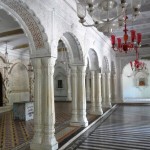2-2.5 kilometers downhill from Rishyap, the 2nd last village of West Bengal a small village within ideal trekking rout. You can go through the main road which is 1 kilometer uphill from Rishyap and then turn left for downhill within the jungle. Other than that there is a short cart. The short cart road is very beautiful and enjoyable for an ideal trek. Start walking from in front of the Resort Sonar Tari for downhill. There is a narrow footpath here. You need to cross a small falls to reach the main village. Cross the village and ask for the “Mandir” road, the villagers will show you the road for Seole Village. There is a big “Shri Shiva Buddha Temple” at the end of the village. Tired?? Take rest and ask water from any village houses, they are very helpful.
Category: Pilgrimage destinations in West Bengal
Popular Pilgrimage destinations in West Bengal
Char Bangla Mandir in Murshidabad
The Char Bangla Mandir or temple is located in Azimganj, Baranagore of Murshidabad district. It was built by Rani Bhavani, the Queen of Natore in 18th century. The temple complex comprises of twin Ek-Bangla temples heavily decorated entrance and the temples standing on 3 arches supported by pillars measuring 0.85m till the first tier and from there to the second tier measuring 0.62m. The main entrance of the complex is west facing and the dimension of each temple is 6.90×7.80m. The height of each of the temple is 5.50m. The temples are exquisite examples of ornamentation on terracotta of Bengal. The temple in the east also has delicate plaster work on it. Some scenes from Hindu puranas and epics have been depicted on the decorated bricks.
Adinathji Mandir at Murshidabad
Adinathji Mandir is situated in the premises of Kathgola gardens which also houses the famous Kathgola Palace. Adinathji Mandir is also known as Pareshnath Temple dedicated to Bhagwan Adishvar. The deity is almost 90 centimeters high sitting on padmasana posture and is believed to be 900 years old. Lakhsmipat Singh Dugar built it in 1933 with white marble making it look pristine. The mandir is absolutely white in color with onion shaped domes. The architecture of the Mandir is influenced by Moghul, European, Rajasthani, traditional Jain and Bengali styles. It houses 17 images of Jain Tirthankaras.
Photo Courtesy: Flickr/Jyoti Prakash Bhattacharjee



